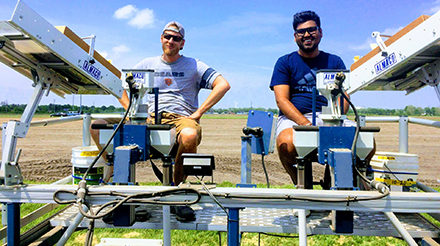Jul 15, 2022USDA ARS researchers look at sweet corn hybrids to increase yields
Sweet corn is one of the most important vegetable crops in the United States, providing an important source of fiber, minerals, and vitamins for humans and for animal feed. ARS researchers and their collaborators are looking at past and present hybrids of the sweet corn crop to determine how farmers can increase yields through plant density — that is, the number of individual plants present per unit of ground area.
The first sweet corn hybrid was introduced in the 1930s, and since then there has been very little to no information on how much these hybrids have changed in recovery and plant density tolerance. Recovery, a trait important to the processing of the product, is how much of the sweet corn kernels ends up in a can or frozen bag.
“Since the corn ear has a maximum size potential, increasing plant density while maintaining per plant yield is the path to higher yields,” said Martin Williams, ecologist at ARS’s Global Change and Photosynthesis Research Center in Urbana, IL.
ARS researchers found that the current sweet corn hybrids differed in plant density tolerance (PDT), and hybrids with higher PDT were being underplanted throughout the Midwest. Optimizing PDT in growers’ fields increased profitability to both growers and vegetable processors, they found.
Looking at previous generations of hybrids proved difficult, since the beneficial research was not yet conducted and many of the previous hybrids were no longer available. Instead, Williams collaborated with experts in the sweet corn seed business to determine which hybrids to remake from each decade in order to study their characteristics. The process of obtaining seeds from the chosen hybrids took about five years. Once they had the seeds, they studied the hybrids in plots with 4,000 plants per acre (low density) while other plots were grown at 32,000 plants per acre (high density).
The research indicated that, over time, newer hybrids performed better at higher densities compared to older hybrids. Meanwhile, they observed that recovery had no improvement throughout the years, which comes as no surprise given that until recently companies and public research programs were not measuring this characteristic. Recovery is essential in the processing industry because the higher the recovery, the less cobs of corn are needed to reach the same amount of product for the processor.
Another upside, particularly for those in the sweet corn business, was that improving plant density tolerance maximized supply and profitability.
“Several processors are asking for modern PDT hybrids from seed companies and exploring the extent to which they can increase seeding rates,” Williams said.
Details on the research can be found at Frontiers in Plant Science.
– Olga Vicente, USDA ARS; Photo at top: Nick Hausman, ARS biological science technician (left) and Daljeet Dhaliwal, graduate research assistant, University of Illinois, planting the field experiment using hybrids from different decades. Photo courtesy of UDSA ARS.















